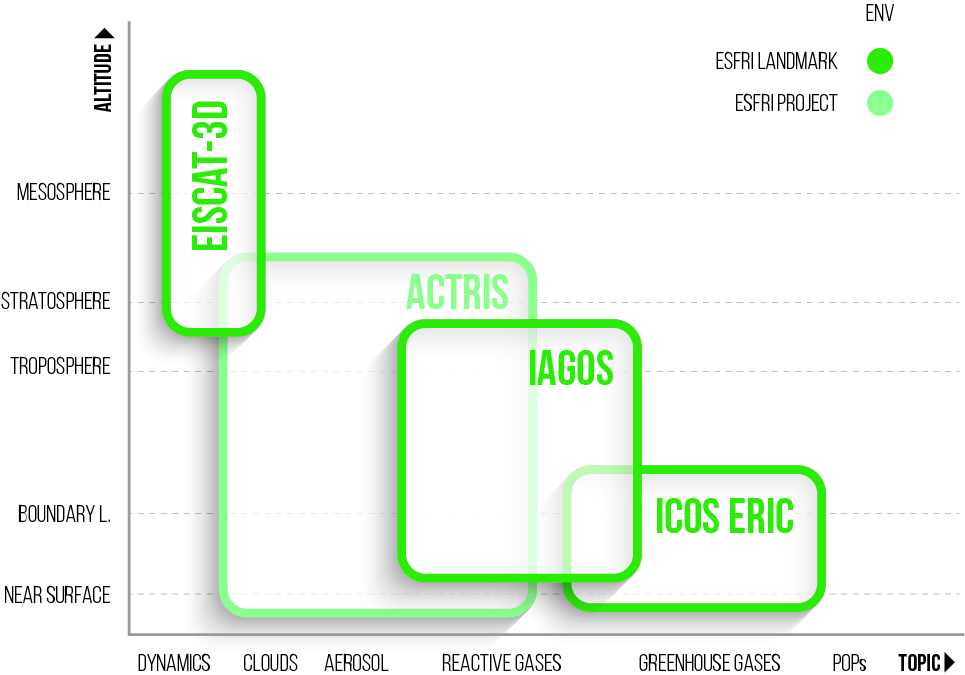Atmosphere
FROM NEAR GROUND TO THE NEAR SPACE ATMOSPHERE
The atmosphere hosts many physical and chemical processes and represents a major part of the environment to which the life on Earth is sensitively responsive. The atmosphere is part of the larger connected global environment and is central for climate, weather, and transport of chemical species
over large distances.
Perturbation of the atmosphere impacts on different thematic areas like climate change, air quality, environmental hazards, environmental risks, food security and the water cycle.
The research on the atmosphere is multidisciplinary, embracing atmospheric chemistry, physics, dynamics and radiation; and it combines observations and modelling. It also has to cover the full altitude range from the planetary boundary layer near the surface across the tropopause and stratosphere
up to the middle atmosphere – i.e from ground to 50 km altitude and beyond. The atmospheric domain interacts with marine, terrestrial, freshwater, solid earth systems and the near space.
The atmosphere contains a wide range of trace species. The identification and quantification of their properties, atmospheric transport and transformation processes and life cycles require highly interdisciplinary approaches. Both natural and man-made gases and aerosols may be transported from emission to receptor sites over long distances in the atmosphere across national borders and continents. Thus, atmospheric research and monitoring requires close international collaboration. Climate change poses a foremost scientific challenge because of large uncertainties in our current knowledge on climate change processes. Particularly, the understanding of climate feedback mechanisms requires considerable joint research where enhanced cooperation of existing Research Infrastructures has to play an important role.
Atmospheric Research Infrastructures do not only provide monitoring, but exploratory infrastructures are also needed to study the processes. Atmospheric processes are multiscale in time and space, from the sub-second, sub-micron scale of microscopic processes to the decadal global scale characteristic of climate change. In this context, the atmospheric infrastructures should be sufficiently equipped to be able to inform across a similar range of scales.
Current Status
The European atmospheric landscape covers a wide range of actions ranging from the establishment of ESFRI long-term atmospheric Research Infrastructures to EU-funded projects such as Integrating Activities (IA), Design Studies, and other projects.
- Long-term atmospheric observation platforms: the ESFRI Project ACTRIS (Aerosols, Clouds and Trace gases Research Infrastructure); the ESFRI Landmark IAGOS (In-service Aircraft for a Global Observing System) (Airborne, lower atmosphere); the ESFRI Landmark ICOS ERIC (Integrated Carbon Observation System); ARISE (Atmospheric dynamics Research Infrastructure in Europe) and the ESFRI Landmark EISCAT_3D (Next generation European Incoherent Scatter radar system) (upper atmosphere); SIOS (Svalbard Integrated Arctic Earth Observing System) (Integrating all observations, terrestrial, marine and atmosphere at Svalbard).
- Exploratory process oriented research, atmospheric chemistry including aerosols: the ESFRI Project ACTRIS; EUROCHAMP 2020 (laboratory studies); EUFAR (Airborne platforms for field experiments).
- Modelling development and experiments: IS-ENES (global climate and earth system models).
The atmospheric subdomain landscape is sketched in Figure 1 in a topic (x-axis) versus altitude (y-axis) graph.

Figure 1. Schematic overview of the ESFRI RI landscape for the atmosphere sub-domain
The European atmospheric research community is well recognised at an international level and in many specific research topics it has an undisputed leadership. Atmospheric RIs have a fundamental role to strengthening the EU position and leadership in this research area by providing unique information, services, tools and reference methodologies that are used and applied by a very wide community also outside Europe.
An assessment of the user community conducted in 2018 in the framework of the cluster of environmental Research Infrastructures (ENVRI) provided more than 3.000 users and more than 25.000 user requests per year for the Atmosphere Domain RIs. Areas of data use include fundamental research on atmospheric processes, climatological studies on the long-term evolution of the atmosphere and trends of key species, validation of Earth System Models, assimilation of data for numerical weather prediction, validation of satellite products and development of new measurement technologies.
One major user of Atmosphere RIs data products and services is COPERNICUS Atmosphere Monitoring service (CAMS)COPERNICUS Atmosphere Monitoring service (CAMS) https://atmosphere.copernicus.eu. The ESFRI Project ACTRIS, and the ESFRI Landmarks IAGOS and ICOS ERIC data are used by CAMS, for example, for Near-Real Time Model Validation, Monitoring Air Quality in Europe and for providing forecast of air quality in Europe for European cities, also shown daily on EURONEWS.
Gaps, challenges and future needs
In response to the status of the existing RIs, specific gaps and challenges have been identified. It is important to study not just components of the atmospheric system but observe as many of those components synergistically as possible to fully understand processes and linkages. A synergistic approach must include the use of in situ ground based observations, together with columnar and vertical profile, aircraft and satellite observations and models to study and understand atmospheric composition and processes. Long-term data records for atmospheric parameters, which are relevant for both air quality and climate research, are inadequate at the moment and the geographical coverage by atmospheric observing infrastructures in the Mediterranean including North Africa and Eastern Europe is incomplete. Understanding the atmospheric composition changes and processes is a global issue, and the relevance for Europe is not limited to observations performed on sites located in European regions; there is a responsibility of Europe to explore where further atmospheric observations could be supported, in Africa to start with. Moreover, harmonised measurements on larger geographical scale are crucial and strong international cooperation is needed. A better integration of existing programs and projects in the atmospheric area will help to build and sustain the European component of GEOSS.
Interconnections with other domains – i.e. Health – need to be better explored. Air pollution is a major environmental risk to health. Short-lived atmospheric compounds have recognized adverse health effects at concentrations typically found across Europe and potentially lead to more than 400.000 premature deaths annually in the EU28. In particular, the effect on children’s health should be better explored and in this context the role of atmosphere RIs to foster scientific cooperation in this field is of primary importance.




